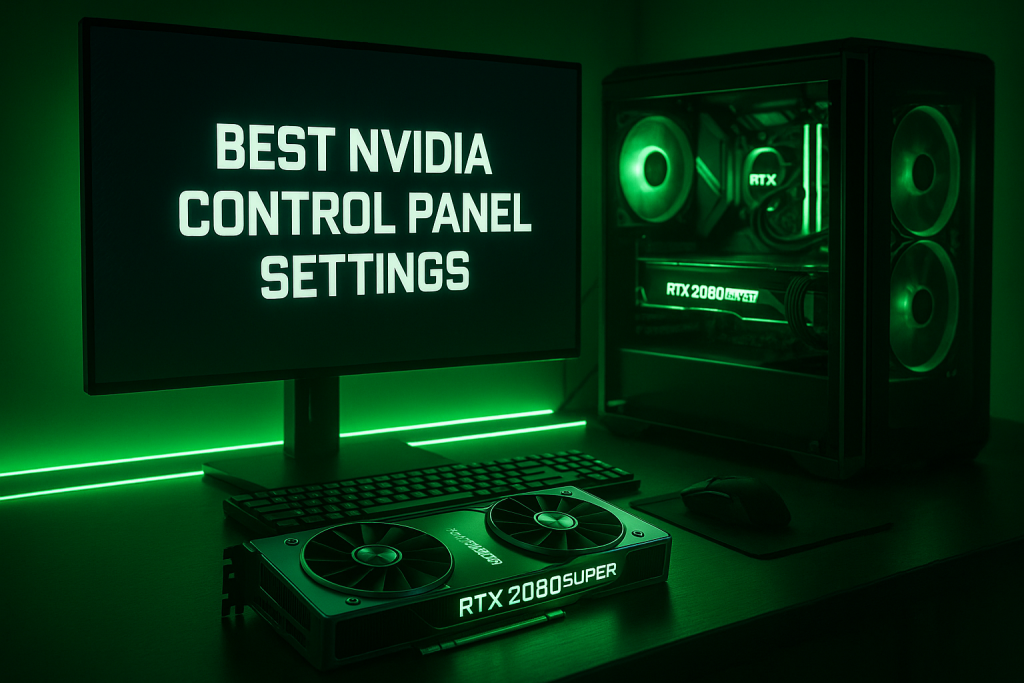⏲️ Estimated reading time: 4 min
Best Settings Nvidia Control Panel RTX 2080 Super. Optimize your RTX 2080 Super for maximum performance and stunning visuals with the best Nvidia Control Panel settings. This guide covers gaming, streaming, and everyday use, ensuring you achieve the perfect balance between FPS, quality, and system stability.
The Nvidia GeForce RTX 2080 Super remains one of the most powerful GPUs from the Turing lineup, offering impressive performance in 1440p and 4K gaming. To unlock its full potential, you need to fine-tune the Nvidia Control Panel settings. Many gamers don’t realize that out-of-the-box settings are not optimized. This article will guide you step-by-step to configure the best Nvidia Control Panel settings for the RTX 2080 Super, improving frame rates, visuals, and overall system responsiveness.
1: Update Drivers
Before changing any settings, ensure you have the latest Nvidia Game Ready drivers installed. Outdated drivers may limit performance or cause stuttering. You can update through:
- GeForce Experience → Drivers tab → Check for updates.
- Direct download from Nvidia’s official website.
2: Nvidia Control Panel Access
- Right-click on your desktop.
- Select Nvidia Control Panel.
- If not installed, download it from the Microsoft Store.
3: Adjust Image Settings with Preview
- Go to Adjust Image Settings with Preview.
- Select Use the Advanced 3D Image Settings.
- Click Take me there to move into 3D settings.
This ensures you control all performance and quality settings manually.
4: Manage 3D Settings (Global Settings)
Here are the optimal RTX 2080 Super settings:
- Image Sharpening → On (Sharpening: 0.3, Ignore Film Grain: 0.17).
- Anisotropic Filtering → 16x (Sharper textures).
- Antialiasing – FXAA → Off (Causes blur).
- Antialiasing – Mode → Application Controlled.
- CUDA – GPUs → All.
- Low Latency Mode → On (For competitive gaming).
- Max Frame Rate → Off (Enable only if you want FPS cap).
- Monitor Technology → G-Sync (If supported).
- Multi-Frame Sampled AA (MFAA) → Off.
- OpenGL Rendering GPU → Select your RTX 2080 Super.
- Power Management Mode → Prefer Maximum Performance.
- Preferred Refresh Rate → Highest Available.
- Shader Cache Size → Driver Default.
- Texture Filtering – Anisotropic Sample Optimization → Off.
- Texture Filtering – Negative LOD Bias → Allow.
- Texture Filtering – Quality → High Performance.
- Texture Filtering – Trilinear Optimization → On.
- Threaded Optimization → On.
- Triple Buffering → Off.
- Vertical Sync (V-Sync) → Off (Enable in-game if needed).
- Virtual Reality Pre-rendered Frames → 1.
5: Configure Display Settings
- Adjust desktop color settings → Use Nvidia settings.
- Increase Digital Vibrance to 55–60% for better colors in games.
- Adjust desktop size and position → Set scaling to No Scaling and perform scaling on Display (if available).
- Change resolution → Always set to native resolution of your monitor. Example: 1920×1080 @ 144Hz or 2560×1440 @ 165Hz.
- Set up G-Sync → Enable for both windowed and full-screen mode (if your monitor supports G-Sync).
6: PhysX Settings
- Go to Set PhysX Configuration.
- Select RTX 2080 Super (not auto-select).

7: Best Settings for Gaming
- Enable G-Sync or FreeSync (if supported).
- Disable V-Sync in Nvidia Control Panel and enable in-game V-Sync only if screen tearing occurs.
- Use DLSS (Deep Learning Super Sampling) in supported games to boost FPS without losing much quality.
- For competitive titles (Fortnite, CS2, Valorant) → prioritize High FPS + Low Latency.
- For single-player cinematic titles → prioritize Ultra Graphics + DLSS Quality.
8: Windows Optimization
- Set Windows Power Plan to High Performance.
- Disable unnecessary background apps while gaming.
- Use Game Mode in Windows 10/11.
Performance Results After Tweaks
With the above settings, users typically gain:
- 5–15% FPS boost in demanding games.
- Reduced input lag in competitive shooters.
- Sharper textures and smoother gameplay at high resolutions.
Key Takeaway
The RTX 2080 Super still packs a punch in modern gaming. By fine-tuning the Nvidia Control Panel, you can achieve a perfect balance of visual fidelity, FPS, and responsiveness. Whether you’re a competitive gamer or a casual 4K adventurer, these settings will maximize your GPU’s potential.
Final Thoughts
Every gaming setup is different, so test these settings and adjust based on your monitor, CPU, and personal preferences. If you want maximum FPS and responsiveness, stick with performance-oriented tweaks. If you prefer ultra visuals, enable higher filtering and DLSS for smooth gameplay.
🔔 For more tutorials like this, consider subscribing to our blog.
📩 Do you have questions or suggestions? Leave a comment or contact us!
🏷️ Tags: Nvidia Control Panel, RTX 2080 Super settings, gaming optimization, best FPS settings, Nvidia RTX tweaks, GPU performance, RTX 2080 gaming, 4K gaming setup, competitive gaming, DLSS RTX
📢 Hashtags: #Nvidia #RTX2080Super #GamingSetup #PCGaming #FPSBoost #DLSS #GSync #NvidiaSettings #GPUOptimization #Gamers
Only logged-in users can submit reports.
Discover more from HelpZone
Subscribe to get the latest posts sent to your email.

